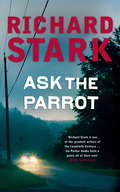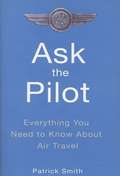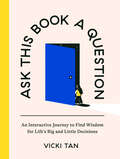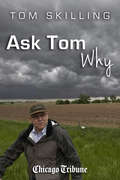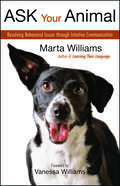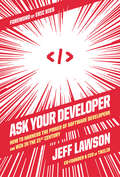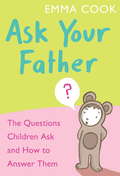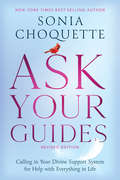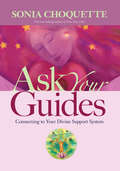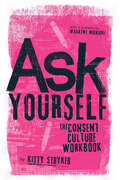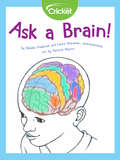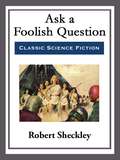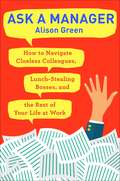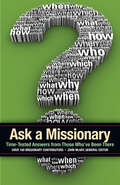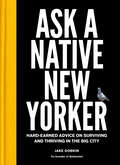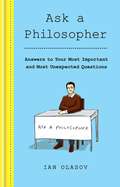- Table View
- List View
Ask The Expert: Tips On Health, Parenting, Nutrition And More From Specialists And Medical Experts
by Bonnie Miller RubinCollecting more than 60 articles written by Bonnie Miller Rubin for the Chicago Tribune between 2011 and 2014, Ask the Expert is a go-to source for questions about health and family. Each article in the series features an interview with a specialist, including a gerontologist, a clinical social worker, and a neuroscientist, among many others. The interviews are concise yet instructive, and Bonnie Miller Rubin's introductory commentary for each article combines helpful foundational information and snappy, engaging writing. Ask the Expert covers a wide variety of topics from cardiovascular troubles and women's hair loss to alternative medicine and avoiding children's mood swings. The first section of the book includes articles about health, covering areas such as aging, end-of-life care, brain health, cholesterol, medical advancements, and mental health. Also included are sections on nutrition, exercise, and weight loss, as well as pregnancy, parenting, and women’s health. The final section of the book includes articles about lifestyle and family issues.
Ask The Parrot
by Richard StarkParker, a professional thief, is on the run after a country town bank robbery goes wrong. There are road blocks everywhere and search parties with bloodhounds are in the woods. As they close in on Parker he is confronted by a local with a shotgun. But this citizen is not out to arrest him; he wants Parker to help him with his own nefarious plans...
Ask The Pilot: Everything You Need to Know About Air Travel
by Patrick SmithThough we routinely take to the air, for many of us flying remains mystery. Few of us understand the how and why of jetting from New York to London in six hours. How does a plane stay in the air? Can turbulence bring it down? What is windshear? How good are the security checks? Patrick Smith, an airline pilot and author of Salon.com's popular column, "Ask the Pilot," unravels the secrets and tells you all there is to know about the strange and fascinating work of commercial flight. He offers: A nuts and bolts explanation of how planes fly -Insights into safety and security -Straight talk about turbulence, air traffic control, windshear, and crashes -The history, color, and controversy of the world's airlines The awe and oddity of being a pilot The poetry and drama of airplanes, airports, and traveling abroad In a series of frank, often funny explanations and essays, Smith speaks eloquently to our fears and curiosities, incorporating anecdotes, memoir and a life's passion for flight. He tackles our toughest concerns, debunks conspiracy theories and myths, and in a rarely heard voice dares to return a dash of romance and glamour to air travel.
Ask This Book a Question: An Interactive Journey to Find Wisdom for Life's Big and Little Decisions
by Vicki TanA one-of-a-kind guide to smarter decision-making based in the science of cognitive bias and the wisdom of storytellingThis book is an interactive game that empowers you to understand yourself in a new way, inviting you on a playful journey of self-discovery. Drawing from the science of cognitive bias, Ask This Book a Question will help you gain the insight you need to approach any decision with confidence. We all take these mental shortcuts, and this book with show you how they influence all aspects of our daily lives, from the way we perceive time, to how the people around us influence us, to our tendency to remember the bizarre over the familiar. When you view your questions in a different light, you&’ll be surprised by how clear your answers become. Start with a question and follow it through thought-provoking visuals and charts to find your journey through the book. Discover a multitude of paths to learn how cognitive biases can either sharpen your judgment or lead you astray: What do I want right now? Consider how the Appeal to Novelty and overstimulation might be draining your attention and resources. Am I drinking too much? Recognize the role of Restraint Bias in your quest for well-being. How do I find my person? Uncover both sides of the Fundamental Attribution Error to deepen connections and navigate conflict with others. Am I spending too much money? Understand how Mental Accounting affects your financial decisions and discover the power of intentional spending. Should I quit my job? Confront the Sunk-Cost Effect to find courage when considering a career change. How can I become happier? Reclaim your leisure hours by finding joy in time confetti, with the Denomination Effect. How do I become lucky? Mull over the big questions of purpose, meaning, and happiness, as you explore Optimism Bias. More than just a one-time read, treat this book like a wise old friend. Keep it close at hand as a trusted reference, turning to the prompts when you get stuck or recognize a cognitive bias at play. Over time, the insights and lessons within these pages will become deeply ingrained, empowering you to make more intentional, self-aware choices. If you&’re ready to unravel the magic of your own mind, understand the patterns they form, and create a narrative uniquely your own, Ask This Book a Question is your essential guide. Dive in and start exploring today – your future self will thank you!
Ask Tom Why
by Chicago Tribune Staff Tom SkillingAsk Tom Why is a collection of articles originally written by Tom Skilling for his Chicago Tribune column of the same name. Skilling, who is WGN-TV's chief meteorologist, answers questions covering all topics pertaining to weather, the sky, and our environment.Split into three sections, the book covers storms and inclement weather; the sun, moon, and sky; and temperature - all expressed with the authority and accuracy of Chicago's favorite meteorologist. Skilling's nearly forty years in the meteorology field make him one of the most trusted voices in a city known for its erratic weather.From the mundane to the anomalous, Skilling explains all things weather in a way that is easy for readers of any age to understand. Ask Tom Why is the first collection of its kind, and a fantastic read for weather enthusiasts, and anyone who grew up reading, listening, and watching Tom Skilling.
Ask Wendy: Straight-Up Advice for All the Drama in Your Life
by Wendy WilliamsGo ahead . . . ask her anythingOver the radio and now on her popular TV talk show, Wendy Williams has always been approached for her blunt, in-your-face words of advice. How's she doin'? "Ask Wendy" has become more than just a fan-favorite TV segment; it's her calling card. Wendy has helped her viewers cope with everything from backstabbing girlfriends and deadbeat boyfriends to crazy mothers-in-law and jealous coworkers. Fans trust Wendy, even when her advice is tough to hear. She's earned her reputation as "the friend in your head."On TV Wendy only has a few minutes to respond to each audience member, but in Ask Wendy she goes deeper, answering questions sourced from viewers across the country. No question is off-limits and no situation is too outrageous for her to take on. Wendy shoots straight from those womanly hips of hers to help you manage all the crazy that comes into your life— keepin' it real by drawing on the personal experiences that have shaped her unique perspective. Wendy reveals never-before shared intimate secrets about struggling with weight, navigating rough times in her marriage, and learning to accept herself. Along with the usual girlfriend, boyfriend, and family drama, Wendy straight-talks on topics like style, body image, and office etiquette, and of course she tackles your wildest sex questions. If you've dealt with it, Wendy has a solution for it.Filled with fun personality quizzes, Wendy's laugh-out-loud anecdotes, and tons of spot-on advice, Ask Wendy will help readers to end the drama in their lives.
Ask Your Angels: A Practical Guide to Working with the Messengers of Heaven to Empower and Enrich Your Life
by Timothy Wyllie Alma Daniel Andrew RamerAngels have been with us in every time and culture, and in many religious traditions. ASK YOUR ANGELS vividly chronicles how they are currentlly reaching out to every one of us in a totally new way, bridging our physical reality with their pure spiritual energy. The authors show us how we can draw on the power of angels to reconnect with our lost inner selves and to achieve our goals, whether they be better relationships, healing an illness, or recovery from addiction.From the Trade Paperback edition.
Ask Your Animal: Resolving Animal Behavioral Issues through Intuitive Communication
by Marta WilliamsAsk Your Animal provides a clear, hands-on guide to relating with animals and nature using intuitive communication. Its step-by-step instructions, true stories, and practice exercises are designed to inspire and guide the beginner. More advanced techniques help you resolve specific issues with the animals in your life — or in your neighborhood. Using this approach, you can start addressing these common situations right away: controlling bad habits like barking and digging • recovering lost animals • calming an animal with separation anxiety coping with an animal’s death • achieving a better bond with your animal • restoring trust in an abused animal creating harmony among the animals in your home • trailering a reluctant horse • eliminating aggressive behavior assisting sick and injured animals • connecting with rescue animals and animals in crisis
Ask Your Developer: How to Harness the Power of Software Developers and Win in the 21st Century
by Jeff LawsonJeff Lawson, software developer turned CEO of Twilio, creates a new playbook for unleashing the full potential of software developers in any organization, showing how to help management utilize this coveted and valuable workforce to enable growth, solve a wide range of business problems and drive digital transformation.From banking and retail to insurance and finance, every industry is turning digital, and every company needs the best software to win the hearts and minds of customers. The landscape has shifted from the classic build vs. buy question, to one of build vs. die. Companies have to get this right to survive. But how do they make this transition?Software developers are sought after, highly paid, and desperately needed to compete in the modern, digital economy. Yet most companies treat them like digital factory workers without really understanding how to unleash their full potential. Lawson argues that developers are the creative workforce who can solve major business problems and create hit products for customers—not just grind through rote tasks. From Google and Amazon, to one-person online software companies—companies that bring software developers in as partners are winning. Lawson shows how leaders who build industry changing software products consistently do three things well. First, they understand why software developers matter more than ever. Second, they understand developers and know how to motivate them. And third, they invest in their developers' success. As a software developer and public company CEO, Lawson uses his unique position to bridge the language and tools executives use with the unique culture of high performing, creative software developers. Ask Your Developer is a toolkit to help business leaders, product managers, technical leaders, software developers, and executives achieve their common goal—building great digital products and experiences. How to compete in the digital economy? In short: Ask Your Developer.
Ask Your Father: The Questions Children Ask - and How to Answer Them
by Emma CookCollected from her highly successful column in the Times - in which she seeks expert opinion to back up her own experience, Ask your Father provides succinct, on-the-button advice to every question from a child you could possibly have the misfortune to be faced with. This will make you laugh all the way to the school gates.
Ask Your Father: The Questions Children Ask - and How to Answer Them
by Emma CookCollected from her highly successful column in the Times - in which she seeks expert opinion to back up her own experience, Ask your Father provides succinct, on-the-button advice to every question from a child you could possibly have the misfortune to be faced with. This will make you laugh all the way to the school gates.
Ask Your Guides: Calling in Your Divine Support System for Help with Everything in Life, Revised Edition
by Sonia ChoquetteWe&’re all spiritual beings with a spiritual support system on the Other Side that oversees and helps guide our lives from the moment we&’re born to the moment we leave our physical bodies and return to Spirit. Not knowing this fact is a severe handicap, as the Universe is designed to care for and nurture all its creatures and help make our life&’s journey easier and more successful. When we learn how to connect with our angelic guides, our lives naturally fall into a pattern of ease and flow during which we grow our souls, fulfill our life&’s purpose, and make our time on Earth endlessly entertaining. This fascinating and inspirational book by Sonia Choquette provides all the information you need to help you connect with your spirit guides so that you can enjoy all the love, abundance, and joy you&’re entitled to.
Ask Your Guides: Connecting To Your Divine Support System
by Sonia ChoquetteWe’re all spiritual beings with a spiritual support system on the Other Side that oversees and helps guide our lives from the moment we’re born to the moment we leave our physical bodies and return to Spirit. <P><P>Not knowing this fact is a severe handicap, as the Universe is designed to care for and nurture all its creatures and help make our life’s journey easier and more successful. When we learn how to connect with our angelic guides, our lives naturally fall into a pattern of ease and flow during which we grow our souls, fulfill our life’s purpose, and make our time on Earth endlessly entertaining. <P><P>This fascinating and inspirational book by Sonia Choquette provides all the information you need to help you connect with your spirit guides so that you can enjoy all the love, abundance, and joy you’re entitled to.
Ask Your Gynecologist: Answers to Over 200 (Sometimes Embarrassing) Questions Women Ask through Every Age and Stage of Their Lives
by R. Scott Thornton Kathleen SchrammAsk Your Gynecologist was written for all of the women who cannot find the information they need to answer their questions about their bodies. Drs. Thornton and Schramm examine the most commonly asked questions and give valuable insight and advice about everything related to gynecology, including pap smears, the menstrual cycle, family planning, infections and disorders, pregnancy, and surgery. Each chapter is divided into questions so readers can look up specific issues quickly. Examples inspired by real women's situations are also included so readers can see that all of their questions are valid and worth asking. Advice on how to choose a gynecologist, when to make an appointment, and how to ensure that daughters visit a doctor is also included, as well as a full glossary and index.
Ask Your Spirit: Receiving Life-Changing Wisdom from Your Elevated Intelligence
by Christine LangWritten by leading medical intuitive and energy healer, Christine Lang, this practical and accessible guide goes beyond the &“trust your gut&” trope so often associated with tapping into your intuition by teaching readers how to converse directly with their enlightened spirit. What if your broken foot is a warning not to accept that new job? What if you got the flu not because of &‘bad luck,&’ but as a cosmic gift to keep you away from a family gathering that became a toxic bloodbath? What if all of your chronic symptoms are hints, pointing you towards a better life, if only you could decipher the clues? Ask Your Spirit answers these questions by teaching you how to converse directly with your spirit. The connection to this invaluable resource provides you with personalized guidance on health, relationships, and career dilemmas. Unlike many spiritual books that simply help you &“increase your intuition&” or offer general tips on connecting to spirit guides, esteemed medical intuitive Christine Lang provides a detailed, step-by-step process for establishing a practical dialogue with the wisest part of you that&’s committed to spiritual growth in this lifetime. This ongoing conversation with your inner wisdom is like having your spirit on speed dial. You&’ll learn how to discern between your soul&’s voice and your ego&’s voice so you can start trusting your spirit&’s priorities, decoding its messages, and understand the expiration date of your messages. Along with client-centered success stories and testimonials from medical professionals, you&’ll see exactly how these practices offer life-changing results.
Ask Yourself: The Consent Culture Workbook
by Kitty Stryker Wagatwe WanjukiWhat does “ consent culture” mean to you? Navigating the complex, never-ending work of culture change can be overwhelming at times. Whether you' re exploring what consent means in your personal life or as part of your work in the world, Ask Yourself guides you through the introspection necessary for lasting change.In Ask: Building Consent Culture, consent culture activist Kitty Stryker compiled a diverse collection of essays from people working on questions of how to build a culture of consent in our everyday world. This timely and practical companion workbook invites you to take a journey through your own thoughts on consent and consider how you can help build consent culture. Ask Yourself guides you through a structured exploration with prompts for 28 days of journaling, conversations and other work. The prompts are split into four sections on distinct themes that allow you to explore consent at your own pace and in your own way. This thoughtful book also features short contributions from consent culture activists to help inspire reflection.
Ask a Brain!
by Natalie FrederickThe brain is your body's control center. It collects signals from your senses, thinks and decides, and sends signals that tell your body what to do. Each part of the brain has a special job, and they all work together as you think.
Ask a Foolish Question
by Robert SheckleyIt's well established now that the way you put a question often determines not only the answer you'll get, but the type of answer possible. So ... a mechanical answerer, geared to produce the ultimate revelations in reference to anything you want to know, might have unsuspected limitations.
Ask a Manager: How to Navigate Clueless Colleagues, Lunch-Stealing Bosses and Other Tricky Situations at Work
by Alison Green'I'm a HUGE fan of Alison Green's "Ask a Manager" column. This book is even better' Robert Sutton, author of The No Asshole Rule and The Asshole Survival Guide'Ask A Manager is the book I wish I'd had in my desk drawer when I was starting out (or even, let's be honest, fifteen years in)' - Sarah Knight, New York Times bestselling author of The Life-Changing Magic of Not Giving a F*ck A witty, practical guide to navigating 200 difficult professional conversationsTen years as a workplace advice columnist has taught Alison Green that people avoid awkward conversations in the office because they don't know what to say. Thankfully, Alison does. In this incredibly helpful book, she takes on the tough discussions you may need to have during your career.You'll learn what to say when:· colleagues push their work on you - then take credit for it· you accidentally trash-talk someone in an email and hit 'reply all'· you're being micromanaged - or not being managed at all· your boss seems unhappy with your work· you got too drunk at the Christmas partyWith sharp, sage advice and candid letters from real-life readers, Ask a Manager will help you successfully navigate the stormy seas of office life.
Ask a Manager: How to Navigate Clueless Colleagues, Lunch-Stealing Bosses, and the Rest of Your Life at Work
by Alison GreenThe ideal graduation gift for anyone about to enter the workforce, a witty, practical guide to 200 difficult professional conversations—featuring all-new advice from the creator of the popular website Ask a Manager and New York’s work-advice columnist. There’s a reason Alison Green has been called “the Dear Abby of the work world.” Ten years as a workplace-advice columnist have taught her that people avoid awkward conversations in the office because they simply don’t know what to say. Thankfully, Green does—and in this incredibly helpful book, she tackles the tough discussions you may need to have during your career. You’ll learn what to say when • coworkers push their work on you—then take credit for it • you accidentally trash-talk someone in an email then hit “reply all” • you’re being micromanaged—or not being managed at all • you catch a colleague in a lie • your boss seems unhappy with your work • your cubemate’s loud speakerphone is making you homicidal • you got drunk at the holiday partyAdvance praise for Ask a Manager“A must-read for anyone who works . . . [Alison Green’s] advice boils down to the idea that you should be professional (even when others are not) and that communicating in a straightforward manner with candor and kindness will get you far, no matter where you work.”—Booklist (starred review) “The author’s friendly, warm, no-nonsense writing is a pleasure to read, and her advice can be widely applied to relationships in all areas of readers’ lives. Ideal for anyone new to the job market or new to management, or anyone hoping to improve their work experience.”—Library Journal (starred review) “I am a huge fan of Alison Green’s Ask a Manager column. This book is even better. It teaches us how to deal with many of the most vexing big and little problems in our workplaces—and to do so with grace, confidence, and a sense of humor.”—Robert Sutton, Stanford professor and author of The No Asshole Rule and The Asshole Survival Guide “Ask a Manager is the ultimate playbook for navigating the traditional workforce in a diplomatic but firm way.”—Erin Lowry, author of Broke Millennial: Stop Scraping By and Get Your Financial Life Together
Ask a Matchmaker: Matchmaker Maria's No-Nonsense Guide to Finding Love
by Author Maria AvgitidisINSTANT NATIONAL BESTSELLERFrom renowned, fourth-generation matchmaker, Maria Avgitidis, comes a fresh, modern dating book that meets anyone navigating the world of dating and relationships where they're at, helping them to attract and grow the partnership of their dreams.In today's world, dating can feel like a never-ending cycle of swipes and small talk, where real connections are hard to come by. But the dream of meeting “The One” isn’t out of reach. Blending personal stories and professional insights, Maria Avgitidis, or Matchmaker Maria, offers the kind of straight-talking, no-nonsense advice that only a true friend can give, guiding you to understand your dating options in a whole new way. By covering everything from personality typing systems to compatibility to Maria’s own developed rules and theories, Ask a Matchmaker equips you to diagnose your own relationship dilemmas and address them with confidence.
Ask a Missionary: Time-Tested Answers from Those Who've Been There Before
by John McVayAsk a Missionary
Ask a Native New Yorker: Hard-Earned Advice on Surviving and Thriving in the Big City
by Jake DobkinAs a third-generation New Yorker who was born, bred, and educated there, Jake Dobkin was such a fan of his hometown that he started Gothamist, a popular and acclaimed website with a focus on news, events, and culture in the city, and “Ask a Native New Yorker” became one of its most popular columns. The book version features all original writing and aims to help newbies evolve into real New Yorkers with humor and a command of the facts. In 48 short essays and 11 sidebars, the book offers practical information about transportation, apartment hunting, and even cultivating relationships for anyone fresh to the Big Apple. Subjects include “Why is New York the greatest city in the world?,” “Where should I live?,” “Where do you find peace and quiet when you feel overwhelmed?,” and “Who do I have to give up my subway seat to?” Part philosophy, part anecdote collection, and part no-nonsense guide, Ask a Native New Yorker will become the default gift for transplants to New York, whether they’re here for internships, college, or starting a new job.
Ask a Nurse
by Amer Assoc of Colleges ofIn the hospital or at the doctor's office, it's the nurses whom patients trust to answer their questions simply, directly, and understandably. So who better to provide inside information about how to manage common health conditions, apply simple home treatments, and make the most of the health care system? Compiling the expertise of 550 nursing schools and 100 nurses nationwide, Ask a Nurse is a one-of-a-kind quick-reference book of invaluable hands-on treatment and healing tips. Every word in it has been written by nurses: nurses who practice nursing, nurses who teach it, nurses who spend all their days working with and caring for patients. They know what works and what doesn't; they can tell you when you need a doctor's care and what you can do yourself. Ask a Nurse focuses on the everyday complaints -- acne, allergies, cuts and scrapes, diarrhea, flu, hemorrhoids, insomnia, stress, and more -- that you can most easily treat yourself, at home in most cases. Arranged alphabetically, the entries explain common conditions, list detailed symptoms, and offer top-to-bottom treatment "menus," featuring everything from effective over-the-counter medications to tried-and-true home remedies and self-care. Alternative and herbal therapies are included: readers will learn, for instance, that devil's claw can ease arthritis pain, tea tree oil can relieve athlete's foot, and a tea bag can reduce swelling. The nurses address men's, women's, and children's unique health issues separately, with special attention paid to identifying and treating addictions and eating disorders; showing what type of contraception to use and how to avoid sexually transmitted diseases; and highlighting when infertility and sexual dysfunction can be handled at home. The nurses also present a complete guide to consumer rights, dispensing tips on how to make a hospital stay more comfortable, choose a reliable pharmacist, put together a home medical kit, and finally, decide when a living will or do-not-resuscitate order is appropriate. With easy-to-find reader-friendly boxes and charts supplementing the A-Z directory of everyday ailments, Ask a Nurse offers readers all the comfort, care, and reassuring practical advice for which nurses have always been known. With 100 nurses putting their names to their personal tricks of the trade, this book provides the insider information that you can use to make wise decisions regarding your health.
Ask a Philosopher: Answers to Your Most Important – and Most Unexpected – Questions
by Ian OlasovThe perfect gift for the smart thinker in your life.For several years Ian Olasov has set up 'Ask-a-Philosopher' booths around New York City, answering questions from passersby. Now in this book he offers answers to the real-life questions on people's minds.From the philosophical to the frivolous, questions include:- Are people innately good or bad?- Is it okay to have a pet fish?- Is it okay to have kids?- Is colour subjective?- If humans colonise Mars, who will own the land?- Is ketchup a smoothie?- Is there life after death?- Should I give money to homeless people?Every question is approached from a philosophical standpoint, but the answer is made fun and accessible for everyone. One of the many joys of this book is that you see how philosophy can be both perfectly continuous with everyday life and also utterly transporting.

